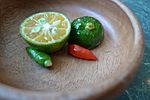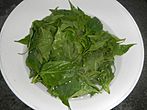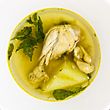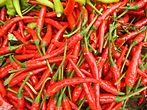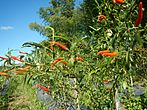Siling labuyo facts for kids
Quick facts for kids 'Siling Labuyo' |
|
|---|---|
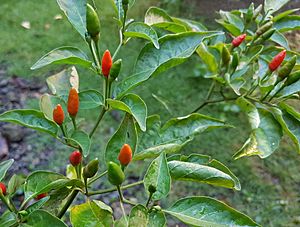
'Siling Labuyo' pepper. The small triangular fruits of siling labuyo are distinctively borne pointing upwards, like other Capsicum frutescens cultivars.
|
|
| Genus | Capsicum |
| Species | Capsicum frutescens |
| Cultivar | 'Siling Labuyo' |
| Heat | |
| Scoville scale | 80,000 - 100,000 SHU |
Siling labuyo is a tiny chili pepper that grows in the Philippines. It became popular there after the Columbian Exchange, which was when plants and ideas were shared between the Americas and the rest of the world. This pepper is special because its small, triangle-shaped fruits point upwards.
The fruits and leaves of siling labuyo are used in traditional Philippine cooking. This pepper is very hot! It measures between 80,000 and 100,000 units on the Scoville scale, which is a way to measure how spicy a pepper is.
The name Siling labuyo comes from the Tagalog language. It means "wild chili." People also call it simply labuyo or labuyo chili. Sometimes, it's called "Filipino bird's eye" to tell it apart from the "Thai bird's eye chili." Even though they look similar, they are different types of peppers. Siling labuyo is one of the two main local chilies in the Philippines.
This pepper is known as the world's smallest hot pepper. Its fruits are usually only about 0.5 centimeters (0.2 inches) long and 0.25 centimeters (0.1 inches) wide.
Siling labuyo is listed in the Ark of Taste. This is an international list of important traditional foods from the Philippines that are in danger of disappearing. It's part of a movement called Slow Food, which aims to protect food heritage.
Contents
What is Siling Labuyo?
Siling labuyo is officially known as Capsicum frutescens 'Siling labuyo. It belongs to the Capsicum frutescens group of peppers. Other peppers related to 'Siling labuyo' include 'Tabasco', 'Malagueta', and 'Peri-peri'.
The common name, siling labuyo, means "wild chili" in Tagalog. Sili means "chili," and labuyo means "growing wild." Labuyo is also a word for a wild chicken. People in different parts of the Philippines have other names for it. Some of these names include katumbal (in Bisaya) and sili ti diablo (in Ilocano).
How Siling Labuyo Looks
Like other Capsicum frutescens peppers, siling labuyo plants grow in a compact way. They usually reach about 0.3 to 1.2 meters (1 to 4 feet) tall. Their leaves are smooth and oval-shaped, about 6.3 centimeters (2.5 inches) long, with pointed tips.
The plants produce small, greenish-white flowers with purple centers. These flowers turn into many small, pointed fruits. The fruits are about 0.5 to 1.8 centimeters (0.2 to 0.7 inches) long. These peppers are very hot and always point upwards on the plant.
When they are young, the fruits are deep green. As they ripen, they turn a bright red color. Some varieties can also be yellow, orange, white, or purple. Flowers and fruits often grow in small groups of 2 or 3 at each spot on the stem.
Even though siling labuyo fruits are tiny, they are very spicy. They measure about 80,000 to 100,000 Scoville units. This is similar to the lower heat range of a habanero chili. At one time, siling labuyo was even listed as the hottest chili in the Guinness World Records. However, even hotter chilies have been discovered since then.
Siling Labuyo in Cooking
Siling labuyo is an important ingredient in Filipino cuisine, though it's not used as widely as some other chilies in Asia. Its leaves are often eaten as a vegetable. For example, they are used in a chicken soup dish called tinola.
The most common way to use siling labuyo is in dipping sauces. These sauces, called sawsawan, are almost always served with fried or grilled Filipino meals. Unlike in Western cooking, people usually make these dipping sauces themselves at the table. They mix siling labuyo with other ingredients like calamansi (a small citrus fruit), soy sauce, vinegar, and patis (Filipino fish sauce).
Siling labuyo is also a key ingredient in palapa. This is a sweet and spicy condiment made with scallions, coconut, ginger, and turmeric. It's very important in the cooking of the Maranao people.
You can also use siling labuyo to make Filipino-style spiced vinegar. Examples include sinamak and sukang pinakurat. Instead of adding fresh chilies to your food, the vinegar itself is filled with lots of siling labuyo and other spices. These spiced vinegars can be stored in bottles for a long time and taste even better as they age.
-
Labuyo chilis and calamansi are mixed with soy sauce, vinegar, and/or fish sauce at the diner's preference to create a dipping sauce (sawsawan)
-
Sinamak, a Filipino traditional spiced vinegar, is made by preserving siling labuyo and other spices in sugarcane or palm vinegar
-
Palapa, a sweet and spicy condiment central to the Maranao cuisine
-
Chicken tinola with siling labuyo leaves
Siling Labuyo as a Natural Pesticide
Siling labuyo can be used as a natural way to protect crops from pests in the Philippines. The fruit, skin, and seeds of siling labuyo are all helpful. They can keep away ants, aphids, caterpillars, Colorado beetles, cabbage worms, and pests that affect stored food.
Using natural pest control methods is part of something called Integrated Pest Management (IPM). IPM tries to help crops grow healthy with as little harm as possible to the environment.
Chilies Often Confused with Siling Labuyo
In Philippine markets, especially in Luzon, some other chili types are often wrongly called "siling labuyo." This happens because these other chilies are usually easier to grow and harvest. They also have a more consistent color and shape, and they stay fresh longer. However, they are not as spicy as real siling labuyo.
One common example is the red bird's eye chili, also known as "Thai chili." This chili comes from a different species (Capsicum annuum) and arrived in the Philippines from Thailand. Unlike siling labuyo, its fruits hang downwards on the plant.
In Luzon, two other types, siling tingala and siling tari, are also often sold as siling labuyo. These are F1 hybrids, which means they are a mix of two different chili types, from Taiwan. They have some C. frutescens in them, so their fruits also point somewhat upwards. But they are much longer and always red, similar to the Thai bird's eye chilies.
- Chili cultivars commonly mislabeled as labuyo chili
-
Siling tingala, an F1 hybrid commonly mislabeled as "siling labuyo" in Luzon markets
-
Siling tari, named after cockfighting spurs (tari), due to the direction of growth of the fruits. It is also commonly mislabeled as "siling labuyo" in markets
See also
 In Spanish: Chile labuyo para niños
In Spanish: Chile labuyo para niños




